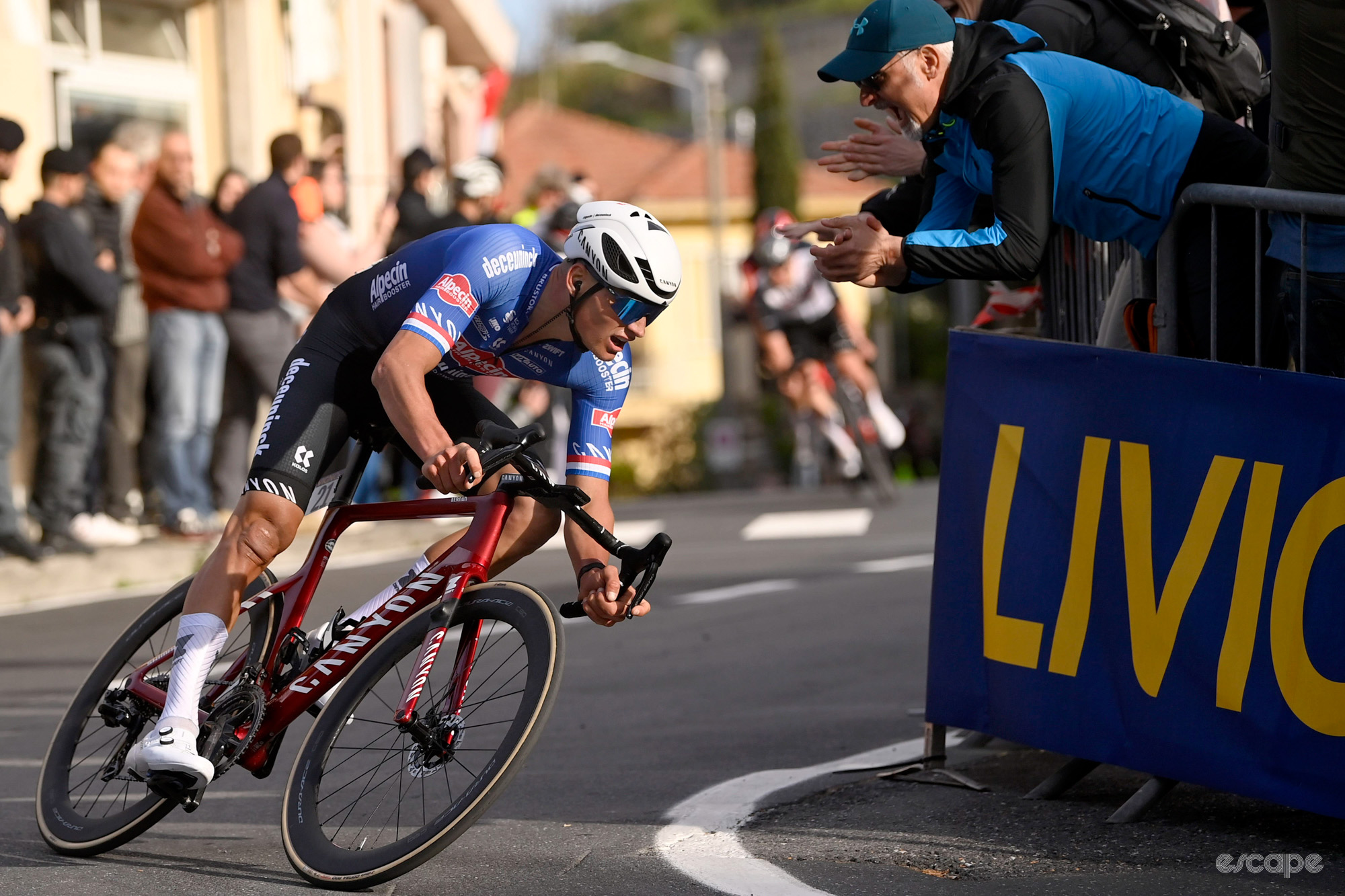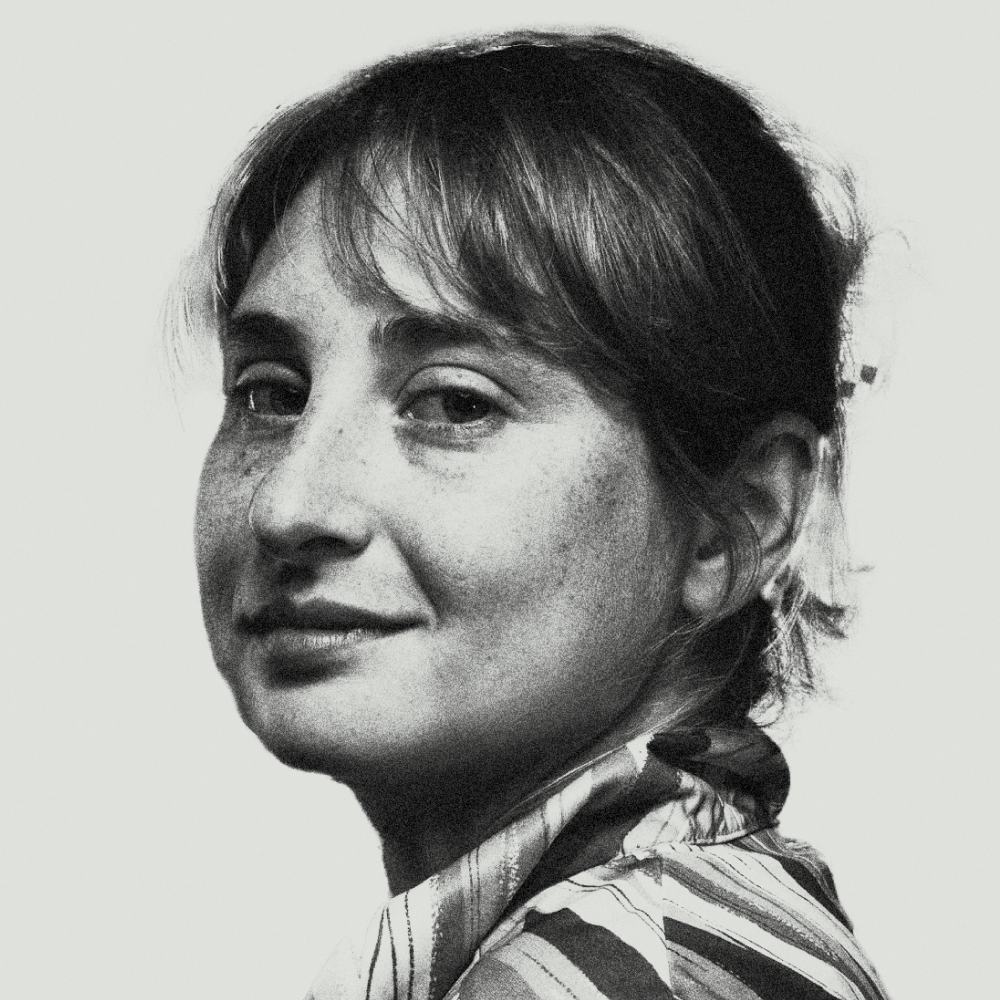It is a misconception that Milan-San Remo really begins at the Cipressa. It begins from kilometer zero. The reason this particular race is so long—mind numbingly long, limb-tiringly long—is because every single kilometer contributes, in a minute sense, to the circumstances of the finale. All that distance affects each rider, each body differently, lulls some and agitates others. It is a tiresome, winding battle—against the wind, the road, boredom, and between whoever sets the pace—which is to say an utterly doomed TV breakaway (although a notable participant is Q.35’s Negasi Haylu Abreha, the first-ever Ethiopian to compete in this race)—and the chase behind, where it falls to Jumbo-Visma’s Jos van Emden to keep them on a short leash. For what seems like an eternity, the Dutch veteran dutifully exchanges pulls with the occasional participant from UAE Team Emirates and Trek-Segafredo. But for over 200 kilometers the race is mostly pulled along by van Emden.
During that long prologue, every twitch feels significant. Tadej Pogačar took a small, mysterious tumble in the neutralized zone—is it over for him? Wout van Aert went back to the team cars. Trouble, perhaps? Julian Alaphilippe got held up and had to barrel down a descent—what does it mean for a flagging Soudal-Quick-step? To say nothing happens before the Cipressa erases all this anxiety, this anticipation, and without it, without trying to read the tea leaves of that first 250 kilometers, is to ignore what makes the finale so cathartic. Without that long wait, Milan-San Remo would not be what it is, which is a Monument. Architecture historians know, after all, that monumentality is a key element of the sublime.
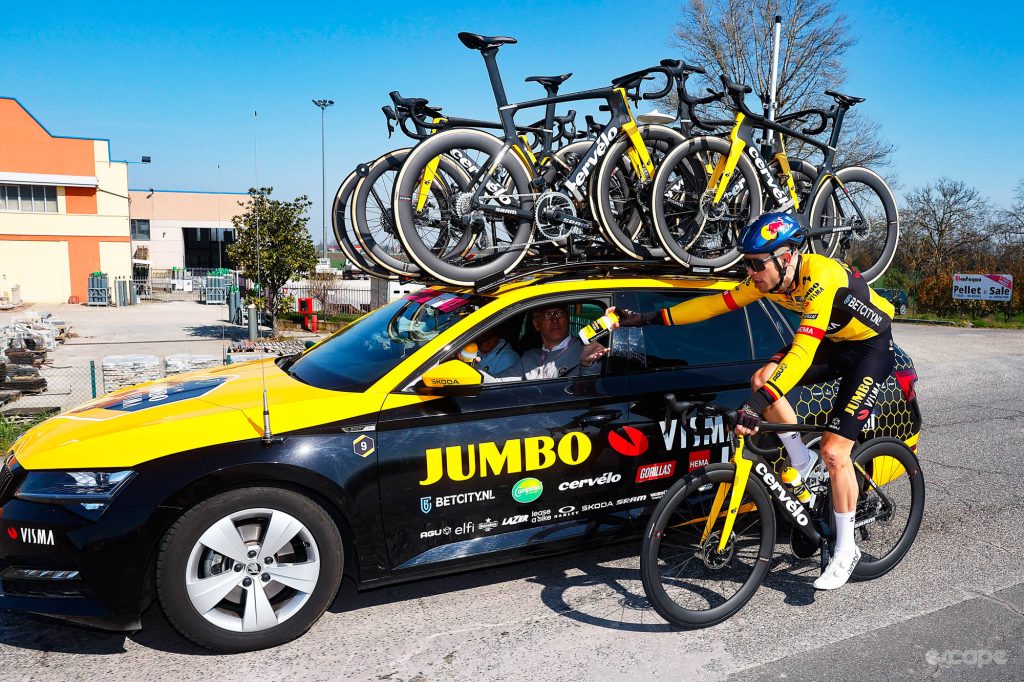
At a certain point, usually when the peloton reaches the coastline, the men begin to assemble themselves. Gone are the nature breaks and the banter with the cameraman, the strange camaraderie of colleagues across teams and nationalities. Something quiets. It’s time to clock in. Every kilometer escalates in importance, a linear progression of stress. In the final 60 kilometers, the consequences of any mistake—Jan Tratnik taking the wrong side of a roundabout and being caught out, for example—multiply in severity. As the peloton enters Alassio, the triple capi: the Mele, the Cervo, the Berta, appetizers to the final dish of the Cipressa and Poggio, loom.
The climbs come in quick, blustery succession. On the Mele, the breakaway begins to fracture and the exhaustion becomes evident, exhaustion that makes such minor climbs feel twice as steep. In the peloton, heavy breaths, stints out of the saddle. For the men up front, their time is nearing an end, but who knows how soon. Above their heads, the sky grays, and beside them the pastel, diorama cities built into crags overlooking the water catch the muted sunlight, as do the tips of waves. There is a slight tailwind, as evidenced by the trajectories of early surfers. Jos van Emden slips back within the peloton. It’s someone else’s turn.
The Cervo. Movistar’s Alex Aranburu falls on his back—at perhaps the last possible opportunity available to him before being lost from the bunch forever. He’s the first victim of the new pace and the fatigue and the narrowing roads. There will be more. It’s crowded. Familiar faces begin to pop up near the front. Pogačar, who took that mysterious spill in the neutralized zone earlier. Van Aert, riding with only the big chainring, stern-faced. In EF pink, Magnus Cort, a clever and brave outsider. The toothy grimace of last year’s winner, the fearless descender and social savant, Matej Mohorič. Even a near-retired Peter Sagan, who said to the press that if he won San Remo he’d retire forever, makes an appearance.
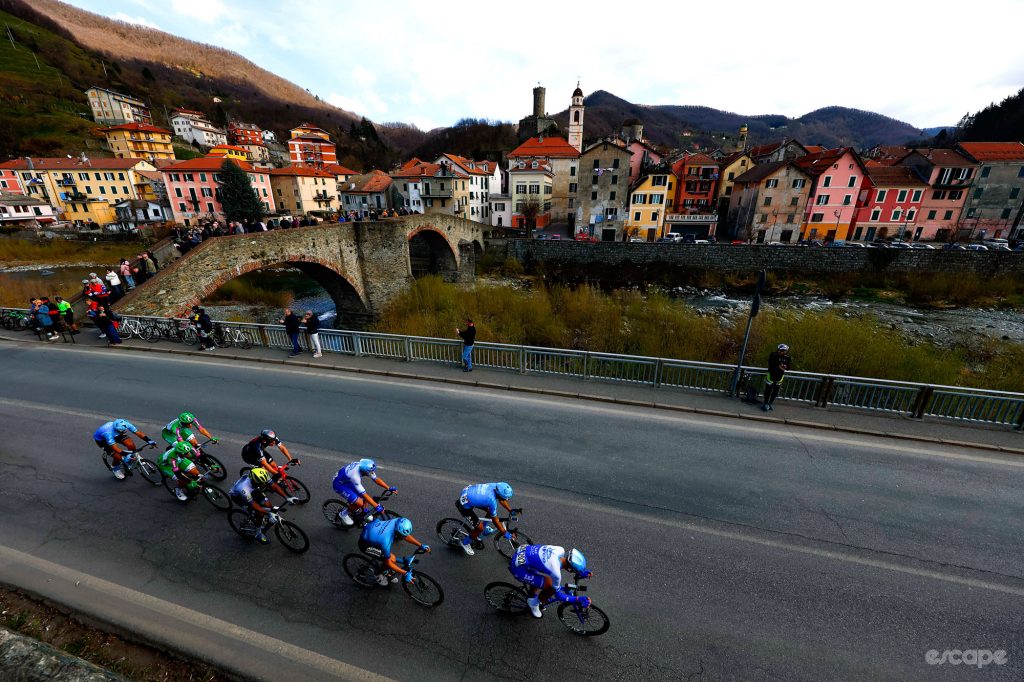
Capo Berta is steep. Short, but steep. The break loses more riders. The peloton’s back door opens to those whose day is too long, and the sprinters Mark Cavendish and Jonathan Milan make an early exit, punished by the pace set, in turns, by Intermarché-Circus-Wanty, Trek-Segafredo, Jumbo-Visma, and EF Education-EasyPost. The descent turns the bunch into a long string. Breakaway riders are sucked back into the bunch. Butter-yellow colonnades crowded with people welcome all into Imperia with cheers. Seven kilometers until the Cipressa. That’s all they must be thinking. Not about the cityscape and the changing light, and the morning becoming afternoon and about the human patterns of development that merge the ancient and the modern. Seven kilometers until the Cipressa. That is all.
33 kilometers to go, three riders crash into road furniture. A missed signal. Two DSM riders and Sam Bennett, the Bora-Hansgrohe sprinter, look on morosely as the bunch move on without them. Later, Tratnik falls, entangled with Michal Kwiatkowski, both necessary parts of their brigades. Potentialities are snuffed before they can be made use of. None of this would have happened if the previous 270 kilometers didn’t transpire beforehand. The breakaway is finally caught. It could not be otherwise.
Now, however, is the time for positioning. Team colors sprawl and merge, cut and dive, all a jumble, trying to reassemble into something useful. Ineos Grenadiers is the first at the front. Then Lotto-Dstny with Arnaud De Lie and Caleb Ewan, who finds his teammate’s slipstream. But the pace is too high, and they, too, fade. Van Aert and Christophe Laporte appear as though by magic. Pogačar’s forces come to the fore and stay there. Tim Wellens. Diego Ulissi. The peloton sheds its dead weight. Too many riders to list. Helpers who did enough for others, selflessly, when no one was looking. A tailwind whips the leaves of the coastal underbrush. All of this happens at once. Alaphilippe, despite his mishap, snags the wheel of his comrades, totally present.
The Cipressa: for many years, no one has won from this hill. Decades have passed. So far, no one thinks of it. Two kilometers to the top. Despite the pace and the tailwind, everyone important is largely able to stay together, which is bad news for Pogačar, who clearly wanted to thin out his fellow climbers, failing, for the second year in a row, to do so. But he does manage to knock out some of the sprinters: Gaviria; De Lie, dangling, gone. One kilometer. They think of the descent. It’s a sprint to meet it. Filippo Ganna and the Ineos Grenadiers lead. Ewan returns, De Lie having sacrificed himself for him. The road squeezes them together, and van der Poel is the first to exit the shadows. Biniam Girmay. Van Aert. The Cipressa is over, the descent of the Cipressa begins.
Little gaps appear, are closed, and appear again. The earth around them is stacked into terraces pierced by the snaking road. The first attempt at victory is instigated by Bora-Hansgrohe’s Nils Politt – both liberated by the departure of Bennett and under pressure to come up with something, anything to salvage the day, fast. Bahrain Victorious swarms, but they are more concerned about the Poggio, about being safe from the chaos. Politt will get caught. Right? He grips his handlebars, hugging the curve of the road. He looks back, forward, back again, vulnerable. He’s ultimately caught, in retrospect, a frivolous provocation, an indication of anxiety.
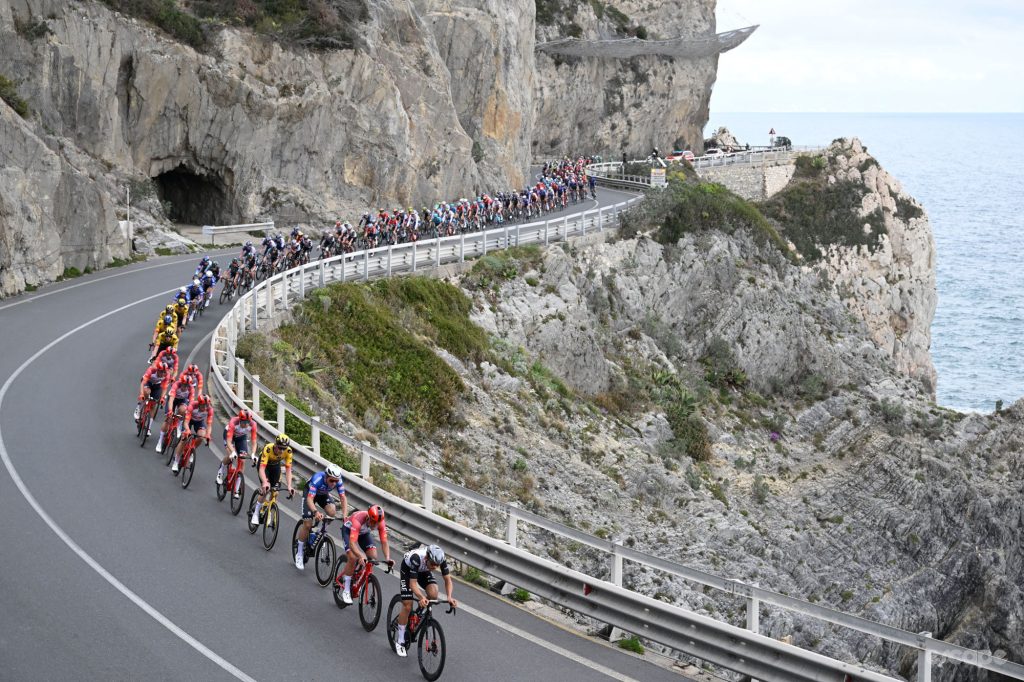
There are two races. The race to the Poggio and the finish. It’s chaos. Men trade positions with one another, steal space from others, snag and claw their way to the front and fight to keep it. No one much cares about the scenery anymore. Someone, however, is not at the front: Wout van Aert. He’s been sucked into the back of the bunch, along with Laporte, his only remaining teammate, but through sheer courage, they make it – at what cost remains unknown.
Finally, the moment, the heavy, anticipated moment, arrives. The Poggio. What Rob Hatch calls the most electrifying 10 minutes of bike racing, and he’s not wrong because before that, there were 290 kilometers of having to live and then later survive. Bahrain works and works and works. A team of seven saved their energy for a single kilometer out of three hundred and then they expire. 7.9 kilometers to go, someone decides it is the moment. Wellens leads out Tadej Pogačar. They brake hard into the corner, steal space. Ganna is there. Van der Poel. Mads Pedersen. It’s closed down, but Wellens still powers his way through, snapping the final elastic of so many men. Most are now teamless. Imagine the ache in the legs, the shoulders, the brain, and that’s why the split happens. Pogačar knows this. He digs, Ganna latches on. Van Aert, van der Poel. Now it’s four. Mohorič, Pedersen, and van der Poel’s teammate Søren Kragh Anderson try to bridge. In this decisive moment, van der Poel senses weakness. He launches across the top of the Poggio, and no one can follow, as though caught by surprise. It’s not over, of course, they tell themselves. Five kilometers is a lot of road.
Van Aert hits the front, powered by his eternal rivalry with the man turning the corners ahead of him, he’s straining around each twist and turn, his eyes able to see what we ordinary people cannot, his body, at this point weak with exhaustion but wracked with adrenaline, still able to navigate nimbly that which would smite the ordinary. Ganna and Pogačar hang on, but van Aert is not cautious. He is not playing games. But neither is van der Poel. He is still alone and the time for being caught narrows and narrows with each meter. Some threshold has been crossed. What’s fascinating about this situation is that the three men behind—Ganna, Pogačar, van Aert—are some of the best time triallists in the world, which explains why van der Poel chose the summit as his point of attack. These men are all physically competent enough to bring van der Poel to heel if they work together. And yet, something transpires. Call it a lapse in tactical nous, call it a clever ploy by van der Poel, or call it “second group syndrome”—the familiar yet frustrating wariness that so often dogs chasing groups like these with a strong leader out front. The three behind no longer work together; why would they, just to lose in a sprint to van Aert? The Belgian now wants someone else to do the pulling after failing to catch the man ahead. They look at each other, and with each glance, the lead slips further and further from their grasp.
A long time ago, in 1961, a man named Raymond Poulidor won this race. This man, dubbed the “Eternal Second,” overshadowed by the stardom of his archrivals Jacques Anquetil and Eddy Merckx, was one of the most beloved bike racers in the history of the sport, a working class hero, humble and pleasant, a daydreamer who enjoyed every second of riding. Cycling transpires on the same roads, follows the same paths, over and over and over again, rewriting the story of those passages every year. Van der Poel glimpses around his shoulder and finds no one. Perhaps he can begin to take in the world around him, the cheers, the air, all the things one savors while making memories to be grasped onto for a lifetime and passed on in stories to his own children and grandchildren, stories van der Poel himself surely heard growing up. Perhaps he sees this final bend as retracing the steps of his grandfather. Perhaps he is remembering that a Dutchman has not won this race in 38 years. Perhaps he is simply thinking about the men who are still behind him. Only when he sees the finish line in Sanremo does he stop looking over his shoulder. He raises his arms, his stoic face now split into a big grin, the afternoon sun opening up to catch the glow of his bike and his helmet and his sweat-drenched skin. It took 300 kilometers to get here, to tell this story. It also took 62 years. 38 years. For Mathieu van der Poel, 28 years old, it took a lifetime.
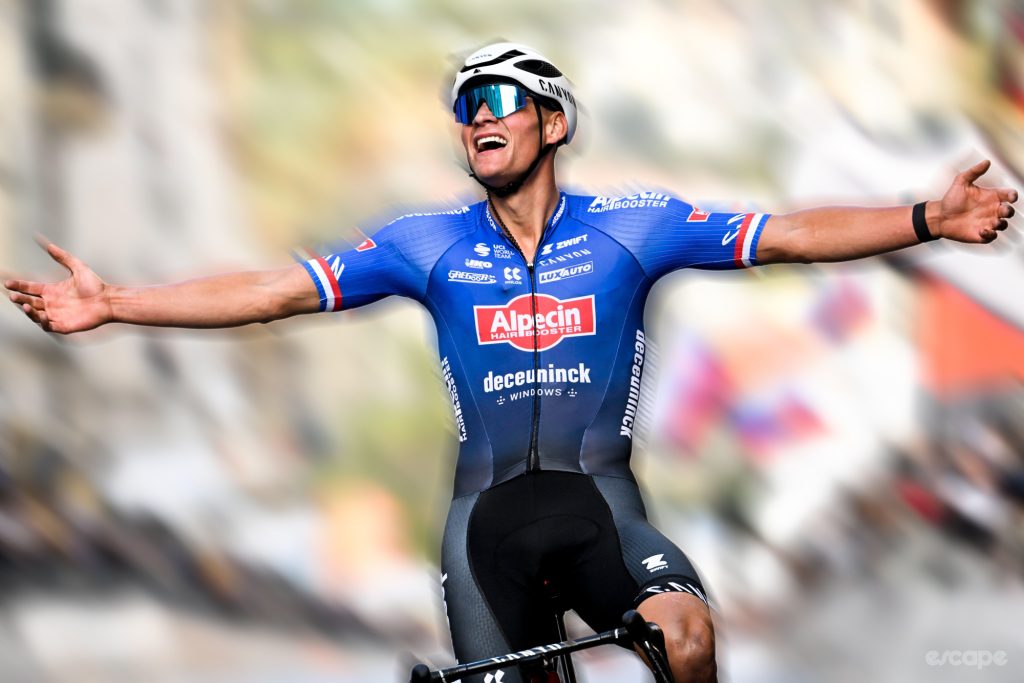
Did we do a good job with this story?
